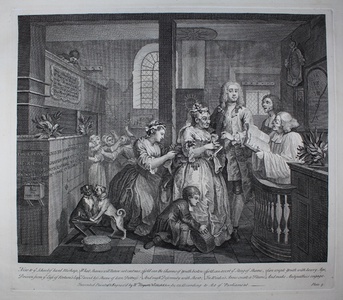| Method | Copper engraving |
| Artist | William Hogarth |
| Published | Invented, Painted, & Engrav'd by Wm. Hogarth, & Publish'd June ye. 25 1735, According to Act of Parliament. |
| Dimensions | Image 310 x 386 mm, Plate 352 x 405 mm, Sheet 411 xx 565 mm |
| Notes |
Plate 5 from Hogarth's most famous moral satire, A Rake's Progress, the successor to his highly lauded 'Harlot's Progress'. Aside from its celebrated subject matter, and its crystallisation of the Rake as an iconic stock caricature in English satire, the series also occupies an important part in the history of printmaking in the British Isles, coinciding with the the passing of 'Hogarth's Act.' Publication of the series was delayed by the artist in an attempt to curb the efforts of copyists, though before the passing of the law, a number of pirated editions had already appeared. The original oil paintings of the series are still extant, and are regarded as being amongst the most significant works in Sir John Soane's Museum. Plate 5: At St Marylebone, Tom has found a means to settle his debts by marrying a one-eyed spinster. The marriage is conducted quickly, no doubt in an attempt by Tom to prevent the interference of Sarah Young and her mother, who can be seen in the vestibule of the church, struggling with a servant in an attempt to object to the union. Sarah has recently been delivered of her baby. Tom, completely unconcerned by the commotion, already seems to have his eye on the attractive young servant tending to his new wife's veil. The church itself is in a state of disrepair, the poor box clogged with cobwebs. Paulson 136 iii/iii, BM Satires 2211 William Hogarth (1697 - 1764) was born in London, the son of an unsuccessful schoolmaster and writer from Westmoreland. After apprenticeship to a goldsmith, he began to produce his own engraved designs in about 1710. He later took up oil painting, starting with small portrait groups called conversation pieces. He went on to create a series of paintings satirising contemporary customs, but based on earlier Italian prints, of which the first was The Harlot's Progress (1731), and perhaps the most famous The Rake's Progress. His engravings were so plagiarised that he lobbied for the Copyright Act of 1735, commonly referred to as 'Hogarth's Act,' as a protection for writers and artists. During the 1730s Hogarth also developed into an original painter of life-sized portraits, and created the first of several history paintings in the grand manner. Condition: Light toning to sheet. Vertical creases and toning to edges of sheet where paper has been folded when previously framed, some loss to the lower of sheet all not affecting the image or plate. Unidentified watermark of a crowned two headed eagle. |
| Framing | unmounted |
| Price | £300.00 |
| Stock ID | 49525 |

